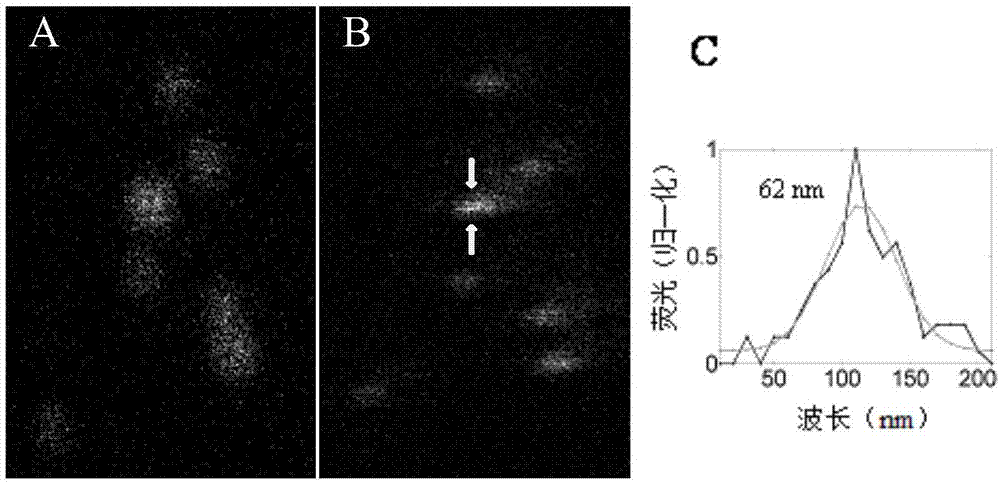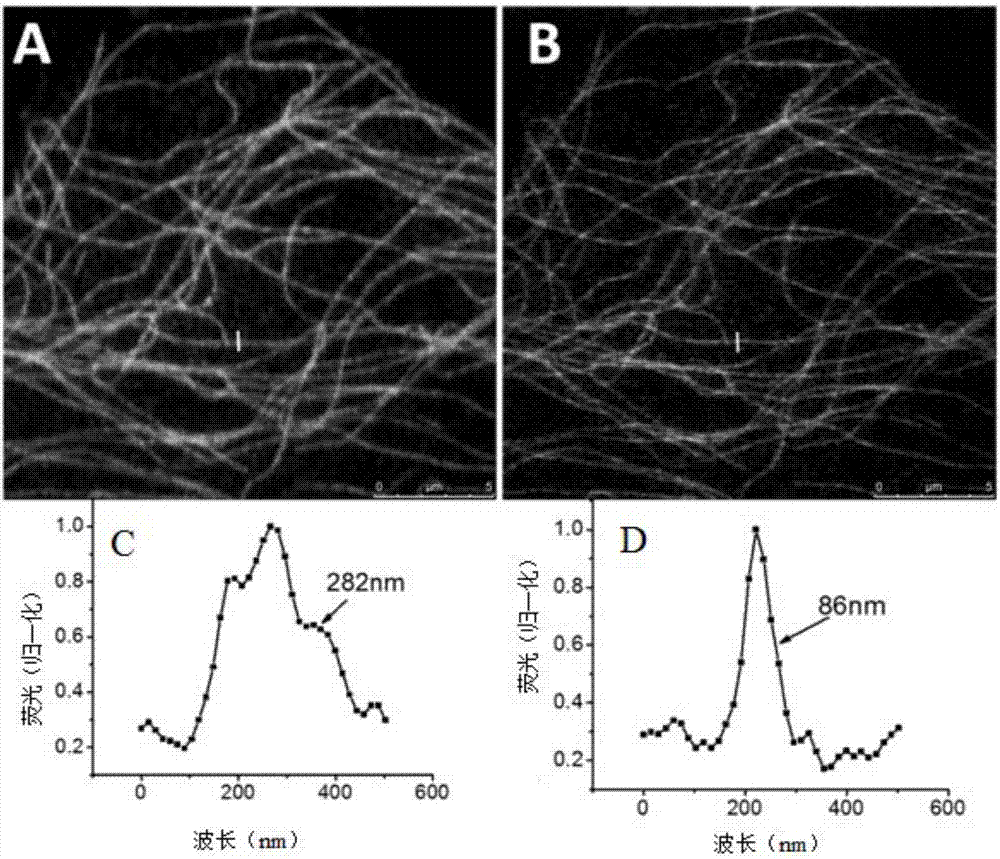Fluorescent bleaching-based super-resolution imaging method
A super-resolution imaging and fluorescence bleaching technology, which is applied in the field of super-resolution imaging based on fluorescence bleaching, can solve the problems of high technical requirements, low universality, and insufficient resolution of ordinary optical microscopes, and achieve resolution improvement and cost reduction , the effect of resolution improvement
- Summary
- Abstract
- Description
- Claims
- Application Information
AI Technical Summary
Problems solved by technology
Method used
Image
Examples
Embodiment 1
[0040] Super-resolution imaging of Alexa405-labeled fluorescent beads.
[0041] 1.1 Alexa405 DNA single strand (sequence: Alexa 405-5'AAAAAACAGGACCAGAAAAAA-3'biotin, TAKARA) was diluted to 100 μM with ultrapure water.
[0042] 1.2 Dilute the polystyrene beads (Invitrogen) labeled with bioavidin to 100 μM with ultrapure water.
[0043] 1.3 Add 97 μL of PBS to the 100 μL centrifuge tube, and add 2 μL of the DNA single strand just diluted and 1 μL of polystyrene beads labeled with bioavidin. This was incubated at 25°C for 1 hour.
[0044] 1.4 Add the incubated solution into a 100KD ultrafiltration tube (Millipore), and then add 300 microliters of PBS.
[0045] 1.5 Put it into a centrifuge and centrifuge at a speed of 2700g for 2 minutes. After taking out the centrifuge tube, pour off the filtered solution, then add 400 microliters of PBS to the centrifuge tube, and centrifuge at a speed of 2700g. After repeating three times, remove the centrifuged liquid.
[0046] 1.6 Put th...
Embodiment 2
[0052] Example 2: Super-resolution imaging of microtubules labeled with Alexa 405 by fluorescence bleaching
[0053] 2.1 Put in the 12-well cell culture plate 18mm round coverslip, on which approximately 60,000 Hela cells were plated.
[0054] 2.2 Wash 3 times with 1 mL of 1× phosphate buffered saline (PBS) at 37°C, with an interval of five minutes between each time.
[0055] 2.3 Add 1 mL of 4% paraformaldehyde (w / v) + 4% sucrose (w / v) to fix for 15 min.
[0056] 2.4 Wash 3 times with 1×PBS buffer, with an interval of 5 minutes each time.
[0057] 2.5 Dilute Triton X-100 to 0.25% (w / v) with 6% bovine serum albumin (w / v). Add 500 μL 0.25% Triton X-100 to the twelve-well plate and incubate for 45 minutes.
[0058] 2.6 Add 400mL primary antibody (10nM) and incubate for 1h.
[0059] 2.7 Wash three times with 1×PBS buffer, with an interval of 10 minutes each time.
[0060] 2.8 Add 400mL of secondary antibody labeled with Alexa 405 and incubate for 45min.
[0061] 2.9 Wash w...
Embodiment 3
[0064] Example 3: Ultra-resolution imaging of Atto 488-labeled cellular microtubules by fluorescence bleaching
[0065] 3.1 Put a φ18mm round cover slip in a 12-well cell culture plate, and spread about 60,000 Hela cells on the slip.
[0066] 3.2 Wash 3 times with 1 mL of 1× phosphate buffered saline (PBS) at 37°C, with an interval of five minutes between each time.
[0067] 3.3 Add 1 mL of 4% paraformaldehyde (w / v) + 4% sucrose (w / v) to fix for 15 minutes.
[0068] 3.4 Wash 3 times with 1×PBS buffer, with an interval of 5 minutes each time.
[0069] 3.5 Dilute Triton X-100 to 0.25% (w / v) with 6% bovine serum albumin (w / v). Add 500 μL 0.25% Triton X-100 to the twelve-well plate and incubate for 45 minutes.
[0070] 3.6 Add 400mL primary antibody (10nM) and incubate for 1h.
[0071] 3.7 Wash with 1×PBS buffer three times, with an interval of 10 minutes each time.
[0072] 3.8 Add 400mL of secondary antibody labeled Atto 488 and incubate for 45min.
[0073] 3.9 Wash with 1...
PUM
 Login to View More
Login to View More Abstract
Description
Claims
Application Information
 Login to View More
Login to View More - R&D
- Intellectual Property
- Life Sciences
- Materials
- Tech Scout
- Unparalleled Data Quality
- Higher Quality Content
- 60% Fewer Hallucinations
Browse by: Latest US Patents, China's latest patents, Technical Efficacy Thesaurus, Application Domain, Technology Topic, Popular Technical Reports.
© 2025 PatSnap. All rights reserved.Legal|Privacy policy|Modern Slavery Act Transparency Statement|Sitemap|About US| Contact US: help@patsnap.com



